
Subscribe to continue reading
Subscribe to get access to the rest of this post and other subscriber-only content.
God of the Sparrow 🌱 By Kathy Manis Findley
"Do not be afraid. You are worth more than many sparrows." Jesus

Subscribe to get access to the rest of this post and other subscriber-only content.

How true it is that when we know nights of sorrow, when weeping is all we can muster, that daybreak does eventually come as it always has. And with the rising of the sun, perhaps our tears are replaced with at least some measure of inner joy.
The universe is wide and wondrous, full of love, full of grace, and sparked by freedom. Those three—love, grace and freedom—are the things we most need, all of us.
I offer you this meditation, praying that you are surrounded in love, that you know the grace that accepts every part of yourself, and that you feel the the freedom to run with the wind in wide and wondrous places, toward your dreams.
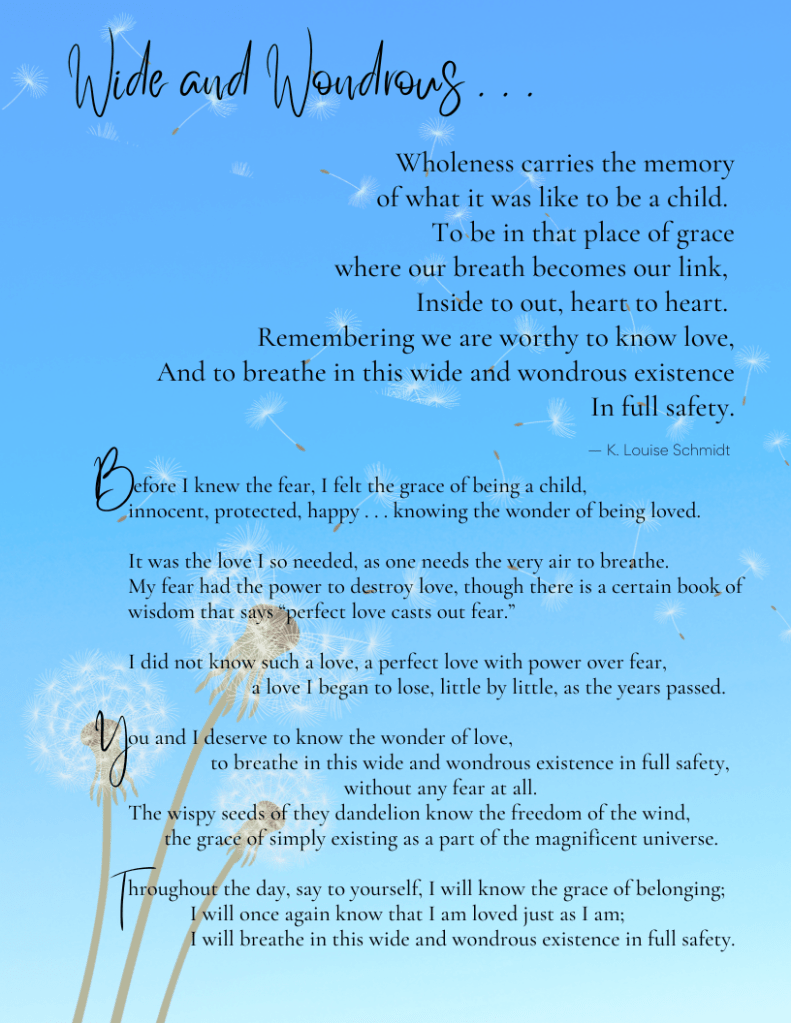
As you continue the quiet time you claim for yourself today, I hope you will be be inspired and comforted by this beautiful choral piece by the brilliant composer Elaine Hagenberg, ”All Things New.”
Poem by Frances Havergal
and text adapted from
Revelation 21:5-6
Light after darkness, gain after loss
Strength after weakness, crown after cross;
Sweet after bitter, hope after fears
Home after wandering, praise after tears
Alpha and Omega
Beginning and the end
He is making all things new
Springs of living water
Shall wash away each tear
He is making all things new
Sight after mystery, sun after rain
Joy after sorrow, peace after pain;
Near after distant, gleam after gloom
Love aftеr wandering, life after tomb

I learned today that happiness in America is at an all-time low. A recent survey from the University of Chicago found that happiness among Americans has fallen lowere than it has been in five decades. What has caused the public’s happiness to plummet is fairly simple—living in the midst of the coronavirus. And that’s the current status of happiness in America.
But happiness is not joy. We can be happy when we find success, or a have a new relationship, or a win a sweepstakes, or watch our children graduate. Yet, even in a state of happiness, we can be without joy. Happiness is an emotion that brings bursts of intense pleasure, excitement, and satisfaction, while joy is a enduring state of being that results in feelings of inner peace and contentment. Joy does not depend on our good luck or our happy circumstances. Joy lives in our hearts, in the deep recesses of our souls. Happiness comes and goes; joy is abiding and eternal.
Still, joy can seem elusive in troubled times. No one escapes trouble. It is an inevitable part of life and, at times, all of us encounter pain, grief, hardship, sorrow, loneliness. Life brings us joy-destroying circumstances. Even Advent Joy cannot change that. We can light the pink candle in our Advent wreaths over and over again, but the pink joy candle cannot bring us joy. The hope, peace, joy and love that Advent might bring to us does not always reach us.
I ask myself: What is it in me that prevents joy from filling my heart? Why does melancholy replace joy in me so often? How do I find joy?
Often, children teach us by their words and actions. Most of them exude joy. I remember hearing children sing, ”I’ve got that joy, joy, joy, joy down in my heart.” The song is actually good theology for children. It is also good theology for adults, especially adults that have lost their joy. I don’t have to search for joy after all. It is ”down in my heart” or maybe down deeply in my soul.
Advent joy is not something you have to work for. Instead, it is something that you hold in your soul that stays with you always. Consider this wise thought:
When you do things from your soul, you feel a river moving in you, a joy.
― Rumi
Or maybe this thought:
I will give thanks to you, O Lord,
for though you were angry with me,
your anger turned away,
and you comforted me.i
Surely God is my salvation;
I will trust, and will not be afraid,
for the Lord God is my strength and my might;
he has become my salvation.
With joy you will draw water from the wells of salvation.
Isaiah 12: 1-3 NRSV

After about five years of co-teaching my Sunday School class, known as the Voices Class, I have had an insight, a rather critical insight. Teaching this class, in particular, has been a gift for me and possibly for the other class members. We have bonded in important and meaningful ways. Most importantly, we “bear one another’s burdens” (Galatians 6:2) and most definitely, we weep with our sisters who have found themselves weeping along the journey. (Romans 12:15)
And what a journey it has been for our class. We began with a lovely Lenten study titled, “Praying with Your Pen,” which took us into the wonderful world of contemplative writing. Such a spiritual disciple leads into all manner of emotional and spiritual discovery, not all of which is positive. The study was emotionally and spiritually taxing at times, while being life-giving for us all.
We then studied a three-month series of biblical women who faced various hardships and later revisited that study for an additional seven weeks. As we followed the journeys of these biblical women, we found kindred spirits and grace for our own journeys. But the lives of the biblical women were harsh, harsh enough to bring up in us an examination of the harshness we have encountered. So this study was a difficult one as well.
Other Lenten and Advent studies through the years kept us in a contemplative, and often melancholy, space where we learned so much about ourselves, our faith and our relationship with God and with each other. We followed Christ Sophia for a while, as we considered the feminine nature of God, and as we followed her, we uncovered spiritual layers in us that have long been touched by Spirit Wisdom.
All of our studies along the way took us to tender places within, places where spiritual maturity occurs and faith deepens. A deepened faith, it seems, was especially important as we entered the pandemic that separated us from each other, at least physically. We adapted valiantly and immediately, and our class continued via virtual Zoom meetings. The meetings, that regularly lasted two hours or more, seemed to ensure our sanity as we navigated pandemic lifestyles that we certainly did not choose. Suddenly, the day to day living became harder, school more complicated, safety measures all-encompassing, family isolation straining. Figuring out this new way to live became draining beyond belief.
That, too, we navigated together, holding one another in the light, learning to find church in uncommon places and keeping each other gathered close, covered in the love each of us brought to our circle. Gathering close to each other was critically important as we lost friends, church members and close family members to this pandemic. Apart from the pandemic tragedies we watched, our class was brought low by other illness and deaths of persons close to us.
So a few weeks ago, my soul cried out, “Enough!” Then I asked myself, ”Where is our joy?” We’ve got the ‘weep with those who weep’ part, God. Can we just move on to the ‘rejoicing with those who rejoice’ part?”
Where is our joy? That’s the part of faith I cannot discern, because right now, it’s just too far away. Still, I asked myself the question.

And I answered myself immediately.
It’s in our hymns! Our joy is in our singing.
So the Voices Class started a new study titled,
Singing Theology: Hymns & the Formation of Faith
Our Worship, Hymnody and Theology
A delightful study it has been for us, as we explore how hymns express the theology of a particular Christian community or tradition. Searching deeply into one hymn each week, we have asked: how does the hymn’s theology shape and form our faith, our belief, our mission and our action? “As the church sings, so she believes,” writes Beth Bowers. We had discovered in this new study an informative, important—and fun—exploration of song!

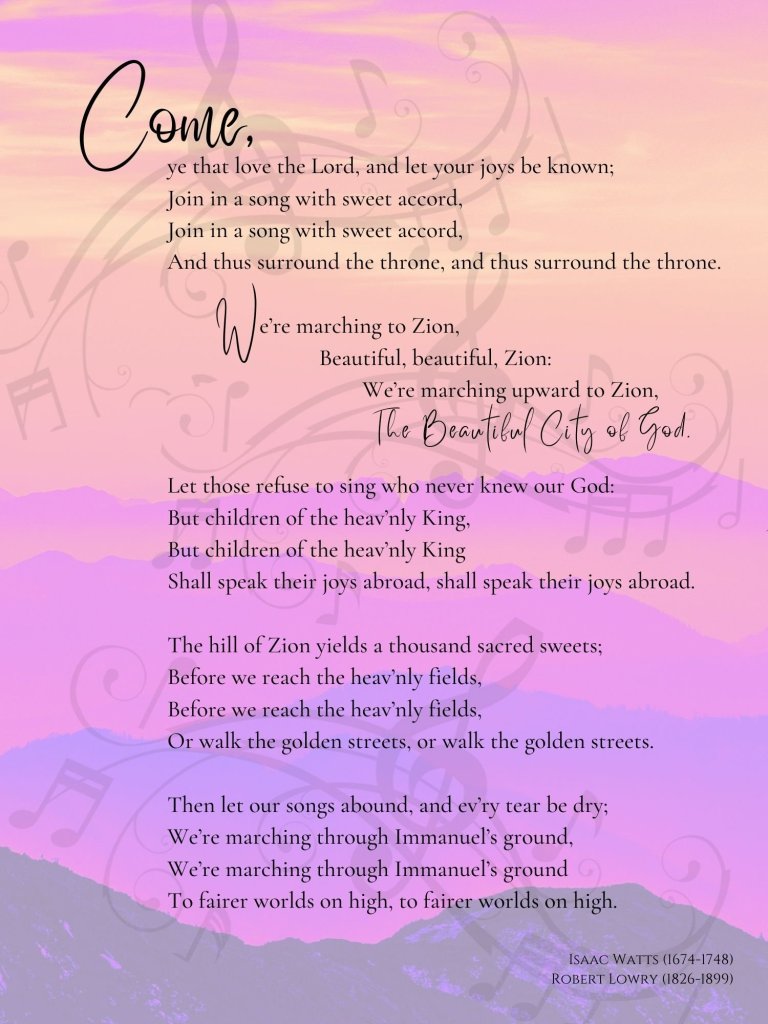






Here is our joy, in the hymns we sing — in their rhythms and their melodies, their thoughts and words. Hymns express our faith, our longing, our petition, our awe, our need, our regret, our grief, our testimony, our theology, our conviction and the deepest joy of our hearts. May it always be so!
My life goes on in endless song
Above earth´s lamentations,
I hear the real, though far-off hymn
That hails a new creation.
Through all the tumult and the strife
I hear its music ringing,
It sounds an echo in my soul.
How can I keep from singing?
While though the tempest loudly roars,
I hear the truth, it liveth.
And though the darkness ’round me close,
Songs in the night it giveth.
No storm can shake my inmost calm,
While to that rock I´m clinging.
Since love is lord of heaven and earth
How can I keep from singing?
When tyrants tremble in their fear
And hear their death knell ringing,
When friends rejoice both far and near
How can I keep from singing?
In prison cell and dungeon vile
Our thoughts to them are winging,
When friends by shame are undefiled
How can I keep from singing?
Songwriters: Eithne Ni Bhraonain / Nicky Ryan / Roma Ryan

Yesterday I noticed a dogwood tree in full bloom, the first blooming dogwood I have seen this year. The sight of it did my heart good, because it reminded me that some simple and beautiful things remain. They return every year. They mark a season. They grow, and their blooms become ever more vibrant, or so it seems.
The dogwood has its own story, a lovely legend that explains the tree’s qualities. The legend holds that the tree was once very large, like a Great Oak tree, and because its wood was strong and sturdy, it provided building material for a variety of purposes. According to the story, it was the dogwood tree that provided the wood used to build the cross on which Jesus was crucified.
Because of its role in the crucifixion, it is said that God both cursed and blessed the tree. It was cursed to forever be small, so that it would never grow large enough again for its wood to be used as a cross for a crucifixion. Its branches would be narrow and crooked — not good for building at all. At the same time, the tree was blessed so that it would produce beautiful flowers each spring, just in time for Easter. The legend says that God it is gave it a few traits so that whoever looks upon it will never forget.
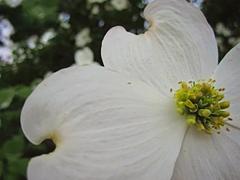 The petals of the dogwood actually form the shape of a cross. The blooms have four petals. The tips of each of the petals are indented, as if they bear a nail dent. The hint of color at the indentation bring to mind the drops of blood spilled during the crucifixion.
The petals of the dogwood actually form the shape of a cross. The blooms have four petals. The tips of each of the petals are indented, as if they bear a nail dent. The hint of color at the indentation bring to mind the drops of blood spilled during the crucifixion.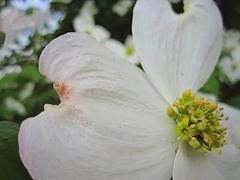
Diana Butler Bass tells the story like this:
There’s an old southern legend that dogwoods grew in Jerusalem — and that one gave its wood for Jesus’s cross. Because of this, the dogwood was cursed (its short stature a ‘punishment’ for being the wood of death) but it also became a blessing. Blessing? For on each twisted branch burst forth petals of lightness and light.
So let’s leave the dogwood’s story and look at our stories — your story and my story. People often use the term “storied past.” Well, a storied past is something all of us have.
In talking with a friend a few days ago, I asked, “How is your heart?” She began to tell me her story, which was a long and winding one that included many mini-stories — happy ones snd sad ones — from her life’s journey. Toward the end of her story, she said, “I feel as if I am cursed by God.” That was her bottom line answer to my question, “How is your heart?” Hers was an honest, heartbroken response that instantly revealed that her heart was not all that good, but that was a critical part of her story.
If you and I are honest, we will admit that our hearts were broken and hurting at several places in our stories. Recalling our brokenhearted times is something we always do when we tell our stories, and it’s an important part of the telling. My story and yours is never complete if we leave out the heartbroken moments, for at those points, what feels like God’s curse almost always transforms into God’s grace.
If not for our heartbroken moments, the hurting places in our hearts might never “burst forth with lightness and light.” Our heartbroken moments change us and grow us. They set us on better paths and they embrace our pain with grace. Our heartbroken moments give us pause, and in that pause, we find that once again, our hearts are good. Our broken hearts are once again peaceful hearts — healed, restored, transformed, filled with God’s grace.
How is your heart? That is a question we would do well to ask ourselves often, because languishing with our heartbreak for long spans of time can cause our stories to be stories mostly of pain. Instead, stop right here in this post for just a few moments and ask yourself, “How is my heart?”

Your answer may well be your path to a contemplative, sacred pause that can become a moment of healing, a time for God’s grace to embrace whatever is broken in your heart and to transform it into love, light and hope. So don’t be afraid to look into your heart when pain is there. In looking, you may find reasons, many and and complex, that are causing deep pain and brokenness. You may also find the healing touch of the Spirit of God waiting there for you and offering healing grace — a Godburst of new hope.
May your story be filled always with times when your was light with joy and times when your heart was broken with loss, mourning, discouragement, disappointment. Both create your extraordinary story — the joyful parts and the sorrowful parts. So tell your story again and again to encourage yourself and to give the hope of God’s healing grace to all who hear it.
I remember a beloved hymn that is a prayer for the Spirit of God to “descend upon my heart.” May this be your prayer today.
Spirit of God, descend upon my heart;
Wean it from earth; through all its pulses move.
Stoop to my weakness, mighty as Thou art,
And make me love Thee as I ought to love.
Hast Thou not bid me love Thee, God and King?
All, all Thine own, soul, heart and strength and mind.
I see Thy cross; there teach my heart to cling:
Oh, let me seek Thee, and, oh, let me find!
Teach me to feel that Thou art always nigh;
Teach me the struggles of the soul to bear,
To check the rising doubt, the rebel sigh;
Teach me the patience of unanswered prayer.
Teach me to love Thee as Thine angels love,
One holy passion filling all my frame;
The kindling of the heav’n-descended Dove,
My heart an altar, and Thy love the flame.

My soul magnifies the Lord, and my spirit rejoices in God my Savior.
He has exalted me and, humbly, His servant I will be.
All generations, henceforth, shall call be blessed.
For He has done great things for me and holy is His name.
I will probably always remember those words penned by a lyricist whose name I cannot remember. (Apologies to John W. Peterson, Anna Laura Page, Ragan Courtney or whoever helped create this arrangement. I remember the tune and every word, but I can’t remember you.)
I have sung, in my short lifetime, dozens of versions of Mary’s song that we know from the Gospel of Luke. We often call it Mary’s Magnificat. I sang the version quoted above many, many years ago as a part of my church’s Advent music. I looked through the music in our first Advent choir rehearsal and immediately turned the pages to this one that was called “Mary’s Song.” I knew I would sing it since the churches we served seldom had willing sopranos.
As November and December moved along, I rehearsed Mary’s Song over and over again, not to enunciate all the lyrics clearly or to sing all the notes correctly. I sang it again and again because the act of getting into Mary’s skin brought me to tears every time I sang it. Tears were okay, but being unable to sing because I was weeping was not okay with me. And yet, I didn’t want to rehearse the emotion out of it. I wanted to “be” Mary for just those moments and I wanted the hearers in the sanctuary to emotionally connect with her.
In the end, I prayed and left it in God’s hands, because in the end, that’s what people of faith do. Today, as we do every year, we lit the Advent candle of joy — the pink candle, Mary’s candle — hoping that the sheer joy of her news to Elizabeth would ring true enough in us to bring us joy. How? “How can this be?” as Mary said to the angel.
I suppose that in these Advent days, in this particular year, many of us have asked “How?” How will we get through this bewildering time? How can joy fill us, enter into our souls and enliven our spirits, as we bury our loved ones? As we wait for word by phone about the person we love who is hospitalized? As we touch the hand of our grandmother through the window of her nursing home? As health care professionals become almost too weary to go on while people with the virus keep coming? As we know we will not see our family this Christmas — to keep them safe, to keep us safe?
How can we sing, this year, “My spirit rejoices in God my Savior” — Mary’s magnificat? Joy is a hard thing this year, for 2020 has brought us grief upon grief, fear upon fear and uncertainty upon uncertainty. Yet, we have held one another close, even over Zoom, because together we have found strength to go on. Over the senseless racially motivated violence we saw on our televisions this year, we saw also a people languishing in a pandemic that took so much.
We saw politicians fighting each other over what some of them see as truth and others see as deliberate, hurtful lies. We saw children who wondered about where school would be and parents agonizing over hard decisions. We saw congregations gathering in parking lots and sanctuaries still, silent, without voices. We saw devastating unemployment and small businesses closing their doors. We saw medically vulnerable or immunosuppressed people locked in their homes. We saw people struggling to pay their bills — very poor people wanting and the very rich, as always, continuing their lavish lifestyles. We saw the rich continuing to oppress the poor, if not in their direct actions, then in their greed that, at least indirectly, deprives those among them who are poor.
The young girl Mary spoke about that, too, in the words of her Magnificat from the Gospel of Luke.
He has shown strength with his arm;
he has scattered the proud in the thoughts of their hearts.
He has brought down the powerful from their thrones,
and lifted up the lowly;
he has filled the hungry with good things,
and sent the rich away empty.
Luke 1:51-53 (NRSV)
The young girl we have called the Virgin Mary, the holy one that accepted the strange and frightening mission from God to bear God’s Son — this Mary is also the subversive one who called out the rich, the powerful and the proud. In her Magnificat? Oh yes, Mary said that God would scatter the proud in the thoughts of their hearts, bring down the powerful from their thrones and send the rich away empty.
Subversive! Courageous! Defiant! Bold! Audacious! Wise! She was all those things when she spoke the kind of subversive truth no young girl in those days would have dared to speak. The miracle of it is that God chose a young girl who possessed the tenderness to nurture a newborn, the wisdom to raise him to live into his mission and the courage to help him stand in a world that would both adore him and hate him — worship him at a manger and then crucify him on a hill. Dr. Marcia Riggs described Mary’s Magnificat like this: “The song sows joy that is the seed of a social revolution.” Indeed!
This was the Mary of our pink candle, the Mary who would be submissive enough to agree to a holy life of chaos and the Mary whose inner strength enabled her to look up and watch her son die.
To be sure, her Magnificat has been read and sung in millions of voices, with thousands of tunes, in cathedral-like sanctuaries and in mud huts. The words have been translated into various versions of the Bible and composers have woven paraphrases of her words into hundreds of melodies and rhythms. Still to this day, one phrase remains . . .
Holy! Holy! Holy is His name.
May Mary’s joy find us on this day and in our own worlds — wherever we are, however we feel, whatever sadness we hold. Amen.
For your quiet, meditative time — one version of Mary’s song:

Today, while minding my own business — and browsing the Better Homes & Gardens website — I stumbled across a stunning image of a tree. Those of you who know me, know that I have had a lifelong passion for trees. Trees, for me, are not only beautiful, they also take me often into a spiritual place. This morning while looking at the bark of the Rainbow Eucalyptus tree (Eucalyptus deglupta), my thought was, “This is almost magic! It can’t be real!”
Rainbow Eucalyptus trees look too beautiful to be real (but they are!) (BH&G)
These trees have an astounding multicolored bark that looks like it’s been decorated with a humongous paintbrush. They seem like something one might imagine, or see in a fantasy movie, or discover in a Dr. Seuss book. But they do grow naturally with a brilliantly colored bark. The Rainbow Eucalyptus, which grow 100 to 200 feet tall, are native to tropical regions like the Philippines, Papua New Guinea, Indonesia and even in the most southern parts of the U.S. “Though pictures of these trees are stunning, they don’t quite capture the awe of seeing them in person.
A real rainbow eucalyptus can stop you in your tracks, so if you have the chance to travel to see them, it’s well worth the journey. (BH&G)
As you would expect, I did some research to find places where I could see this magical tree in person. San Diego, California, is actually becoming a travel destination for seeing these trees. One can see them at Balboa Park, along Sports Arena Boulevard, at the San Diego Zoo, and in parts of Mission Bay. One can also see them in parts of Florida, Hawaii and Texas. So there really are a few places you can see a Rainbow Eucalyptus without needing a passport.
You might ask, “What’s so important about a tree that looks fake?” And that would be a good question. I’m not sure I have a coherent answer, but I’ll give it a shot. Sometimes we find ourselves in places that feel “blah.” We’ve lost our sense of direction and maybe even our will to move forward in life. Those times can come to us because of grief, illness, family challenges, concern for our children, stagnancy in our careers, waning spirituality or simply feeling out of sorts. Hundreds of life circumstances can bring us to a lethargic or depressed place in life. It’s not a very good place to be, and most of us wonder how we got to such a place.
In those times (and there have been many) when lethargy got the best of me, I tended to search for a bit of magic. No ordinary remedy seemed adequate. I just needed some magic and I have discovered over many years that magic can be found in a myriad of places, beginning with some very hope-filled passages of Scripture.
There is nothing better for mortals than to eat and drink, and find enjoyment in their toil. This also, I saw, is from the hand of God; for apart from him who can eat or who can have enjoyment? For to the one who pleases him God gives wisdom and knowledge and joy . . .
— Ecclesiastes 2:24-26 (NRSV)
In the day of prosperity be joyful, and in the day of adversity consider; God has made the one as well as the other . . .
— Ecclesiastes 7:14 (NRSV)
So I commend enjoyment, for there is nothing better for people under the sun than to eat, and drink, and enjoy themselves, for this will go with them in their toil through the days of life that God gives them under the sun.
— Ecclesiastes 8:15 (NRSV)
For you shall go out in joy
and be led forth in peace;
the mountains and the hills before you
shall break forth into singing,
and all the trees of the field shall clap their hands.
— Isaiah 55:12 (ESV)
Nehemiah, who was the governor, and Ezra the priest and scribe, and the Levites who taught the people said to all the people, “This day is holy to the Lord your God; do not mourn or weep.” For all the people wept when they heard the words of the law. Then he said to them, “Go your way, eat the fat and drink sweet wine and send portions of them to those for whom nothing is prepared, for this day is holy to our Lord; and do not be grieved, for the joy of the Lord is your strength . . .” And all the people went their way to eat and drink and to send portions and to make great rejoicing . . .
— Nehemiah 8:9-12 (NRSV)
And always, words from the Psalmist:
You show me the path of life.
In your presence there is fullness of joy;
in your right hand are pleasures forevermore.
— Psalm 16:11 (NRSV)
I believe that I shall see the goodness of the Lord in the land of the living.
— Psalm 27:13 (NRSV)
Delight yourself in the Lord, and he will give you the desires of your heart.
— Psalm 37:4 (ESV)
These messages from the pages of the Bible bring me joy and a bit of relief from feeling down. Being lifted from depression, sadness, the doldrums and other similar difficult seasons of life can feel like magic, magic that can be found in lots of places — if we’re paying attention. The magic may be found in a forest with a verdant canopy of leaves we can see if we look up. It may be found in the laughter of a child or in listening to joyful songs, the rhythmic melody moving through the heart. Magic may be found in loving relationships, in a garden, in a place of prayer and contemplation. You and I might find magic in birdsong or in the cloud shapes we see in the morning sky. We can even find magic in the darkest of our nights — for 100 thousand million stars sparkle for us in the Milky Way — a gift from the Creator, shining out of the darkness.

Today, I found magic in the most unlikely place — in the bark of Rainbow Eucalyptus trees. At least it felt like almost magic! I happened upon this treasure of nature quite by accident, or perhaps it was by providence. Anyway, catching sight of this whimsical, majestic tree brought me the joy of remembering afresh the varied potpourri of the gifts of creation, coming from God, the Father/Mother of lights.
Every good gift and every perfect gift is from above, and comes down from the Father of lights, with whom there is no variableness nor shadow of turning.
— James 1:17 (NKJV)
Thanks be to God for unspeakable gifts of grace. Amen.

Women in white gowns emerge from the crashing water of a moonlit waterfall. What in the world does that have to do with me, other than the fact that I am completely enthralled by this painting? I certainly cannot relate or see myself emerging from rushing waters or even dancing with a tambourine in my hand. Yet, there is something about this art that inspired my soul searching and brought up some questions I want to contemplate.
Where did I come from? Where will I go?
What will I do with my life? Which of my dreams will I realize?
I have asked myself similar questions, questions about what made me who I am and if I will ever feel that I have realized my life dreams. It’s true that I have entered my seventieth year of life, and one might wonder why the need for all the introspective questions. But In the core of my being, I believe that I can still dream and that I can still experience wonder about what I see in and around my life.
What people will enter my life leaving cherished gifts of friendship? What wonder will I see around me as I search for meaning? What will Spirit say to me with the gentle breath of her voice that can also enter my life as a rushing, mighty wind? And how does God continue to call me to new ministries of the heart?
I do not know the answer to those questions. Nor do I know who or what I will be when I grow up. So I struggle to know. I plead with God to give me direction. During this season of my life while I am challenged with so many things related to my kidney transplant, I have been somewhat obsessed with finding the answers to all those “who am I?” questions. I despair a little when I can’t find the answers.
Back to the art. Yesterday, I accidentally came across the painting by Canadian artist Rob Gonsalves which is at the top of this post. I was immediately captivated by the image, especially the rushing waterfall that changed into women living life — some of them dancing, others playing their tambourines, others just emerging, still others just beginning to awaken.
The art reminds me of how we might emerge into life — to grow into life, to be open to change, to be willing to embrace a process of becoming. Each of us is engaged in that kind of process whether we know it or not, whether we embrace it or not. We want to experience an awakening that opens our eyes to wonder and our souls to extraordinary newness of life. We want the freedom to be who we are. We don’t want to stay in our awakening place, reticent about moving into the best part of our lives, refusing to move because of our fear. We want to throw off our hesitation and, in search of our dreams, to sing, to dance, to play our tambourines in celebration of our unique personhood.
I am reminded of a beautiful passage of Scripture from the Psalms.
Let them praise his name with dancing,
making melody to him with tambourine and lyre.
— Psalm 149:3 (NRSV)
Isn’t that precisely what we want for our lives? To lean into our true selves so that we are compelled to sing, to dance with tambourines in our hands, to celebrate our lives, to dream and to praise the God who rejoices when we live into freedom and joy!
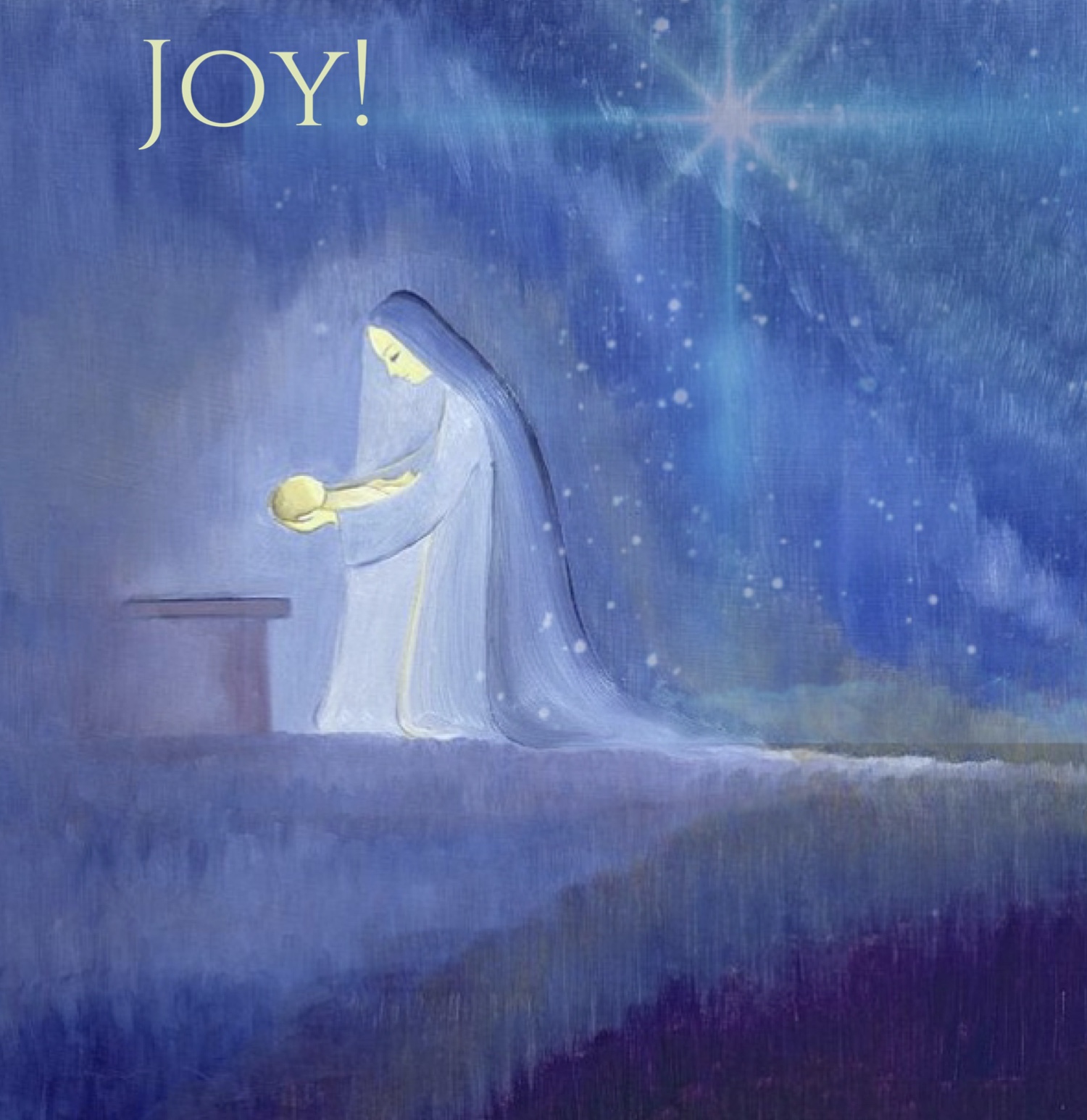
The Third Sunday in Advent
The Sunday of Joy
December 15, 2019
How I love the pink candle on this day of joy! We light the purple ones each week until today, and then there is this surprising burst of color — lighter, brighter, pink — that proclaims to us that life for us is joy. Always!

And joy is ever-present within us. No matter the circumstances we face, joy is waiting to emerge from our deep-down place. Joy was a part of the package that entered our lives when we professed our faith in Christ, and joy was there when we received grace, acceptance and God’s abiding presence. And so today we reflect on that joy and, like Mary, we treasure it and ponder it in our hearts. (Luke 2:19)
Now about Mary, God-chosen Mary — her joy must have been overwhelming when the surprise from out of nowhere was delivered by an angel! And yet, other emotions came along with that joy — fear, confusion, bewilderment, concern. And questions! Many questions like “How could this happen?”
I do not need to tell you that questions, fears, concerns are always a part of our lives, but underneath them in our inner soul, joy abides. Consistent, continual joy that hides until we really need it and then bursts upon us to remind us that the troubles of the day are superseded. Then we know the truth of what we heard from the beginning: “Don’t be dejected and sad, for the joy of the Lord is your strength!” (Nehemiah 8:10)
Mary sang of deep joy in her devotion to God —“My soul magnifies the Lord and my spirit rejoices in God, my Savior.” But there was for her a barrage of other emotions. The poetry of Ann Weems explores that:
MARY, NAZARETH GIRL
Mary,
Nazareth girl:
What did you know of ethereal beings
with messages from God?
What did you know of men
when you found yourself with child?
What did you know of babies,
you, barely out of childhood yourself?
God-chosen girl:
What did you know of God
that brought you to this stable
blessed among women?
Could it be that you had been ready
waiting
listening
for the footsteps
of an angel?
Could it be there are messages for us
if we have the faith to listen?
—Ann Weems
Maybe, just maybe, Mary “had been ready, waiting, listening for the footsteps of an angel?” And in that holy visitation, I imagine that the emotion she felt most deeply in her soul was joy. She was destined to be the mother of the Christ Child, the mother who would lead him and teach him and prepare him.
Emulating the young girl, Mary, let us face the obstacles and surprises that come our way, knowing that our deepest, abiding joy will arise in us when we most need it. 
Our message for this Sunday of Joy sings to us the words of a beloved carol:
O ye, beneath life’s crushing load, whose forms are bending low,
Who toil along the climbing way with painful steps and slow;
Look now for glad and golden hours come swiftly on the wing;
O rest beside the weary road and hear the angels sing.
Today’s good word — and the lighting of the pink candle — urges us to never forget the promise: “Tidings of comfort and joy!”
We probably won’t hear the flutter of angel wings or the footsteps of an angel coming to us when our joy shows up. But with God, who knows?
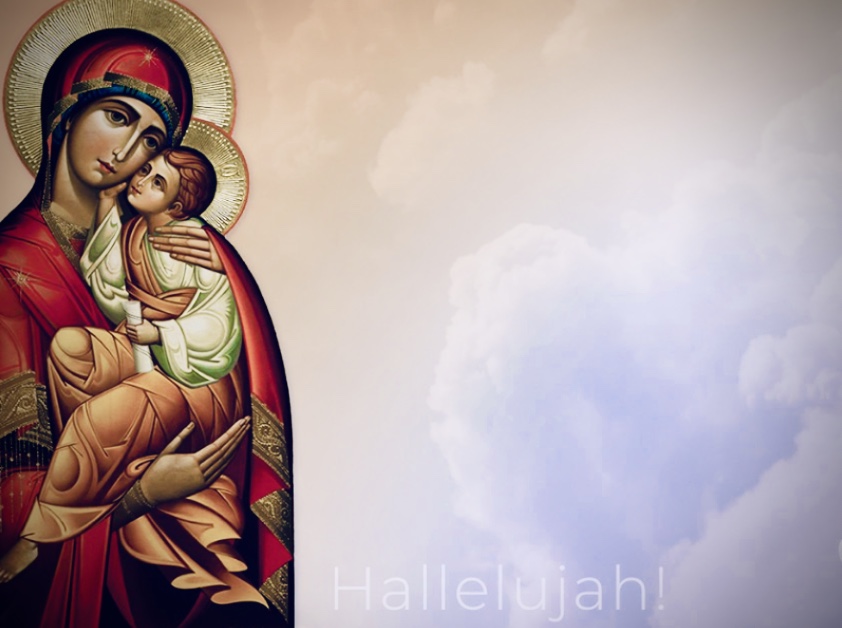
The Tenth Day of Advent.
December 11, 2019
IN SEARCH OF OUR KNEELING PLACES
In each heart lies a Bethlehem,
an inn where we must ultimately answer
whether there is room or not.
When we are Bethlehem-bound
we experience our own advent in his.
When we are Bethlehem-bound
we can no longer look the other way
conveniently not seeing stars
not hearing angel voices.
We can no longer excuse ourselves by busily
tending our sheep or our kingdoms.
This Advent let’s go to Bethlehem
and see this thing the the Lord has made known to us.
In the midst of shopping sprees
let’s ponder in our hearts the Gift of Gifts.
Through the tinsel
let’s look for the gold of the Christmas Star.
In the excitement and confusion, in the merry chaos,
let’s listen for the brush of angels’ wings.
This Advent, let’s go to Bethlehem
and find our kneeling places.
— Ann Weems
The words of Ann Weems this morning seem to call us to Bethlehem. Perhaps the call intends for us to remember more clearly the birth of the Christ Child, the incarnation of God. Perhaps this call wants us to focus more fully on what this Child’s birth really means for us. Perhaps the call wants us to find our kneeling places, those places that enable us to open ourselves to God’s presence in us, God’s call to us.
When, in your own kneeling place, have you responded to a call from God? Was it a call that would change your life? Was it a call that you could only answer by saying, “Here am I. Send me.”
Among all the meanings of Advent is a call to watch, to wait, to worship, to be full of expectation, to rejoice in the birth of the Christ Child and to offer our lives to God. Advent is a call to find our kneeling places.
So I am thinking today about the many ways God has called me through the years. Some of those calls became divine appointments for me. Some were hard calls, risky and frightening. Some were calls that I answered with an immediate “Yes!” There were calls that summoned me to find my kneeling places. One specific call is the one that emerged from my most impassioned, fervent kneeling place. It was the call that asked, “Whom shall I send? And who will go for us?”
To respond “yes” to that call required extended time spent at my kneeling place. To respond “yes” to that call would alter the course of my life. Looking back, I can see that saying “yes” to that call call brought me life’s deepest sorrows and matchless joys. That call from God was to be transformative for me, transcending whatever I had imagined. I vividly remember that call, and from my kneeling place, I answered, “Here I am, Lord.”
“Here I am,Lord!” Those words from my heart would bring a plethora of emotions in the months that followed — through times of testing, disparagement, condemnation, criticism, disappointment, struggle, and eventually, peace. Thinking back to my ordination service brings a host of special memories: my friends and family gathered for the holy service; the church family that laid hands of blessing on me; my husband and my best friend singing words I remember to this day.
Here I am, Lord.
Is it I Lord?
I have heard You calling in the night.
I will go Lord if You lead me.
I will hold Your people in my heart.
I, the Lord of sea and sky,
I have heard my people cry,
All who dwell in dark and sin
My hand will save.
I have made the stars of night.
I will make their darkness bright.
Who will bear my light to them?
Whom shall I send?
I, the lord of wind and flame,
I will tend the poor and lame,
I will set a feast for them,
My hand will save.
Finest bread I will provide
Till their hearts be satisfied.
I will give my life to them,
Whom shall I send?
— Songwriters: Anna Laura Page / Daniel L. Schutte; Based on Isaiah 6:8 and 1 Samuel 3
If you like, take a few minutes to view the video of this song, reflecting on the words and their meaning for you.
And so it was, from my kneeling place, I answered God’s call: “Here I am, Lord!”
The season of Advent calls us in a voice just as compelling to find our kneeling places . . .
to focus on Advent’s promises of hope, peace, joy and love,
to wait in anticipation for the birth of our Savior,
to lift our eyes and sing with the angels, “Hallelujah!”
Amen.